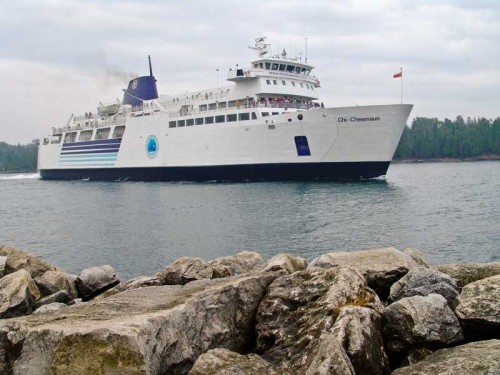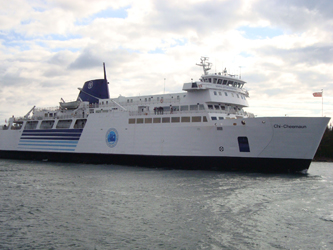Almost six months ago, The Expositor printed a front page editorial, something that this or any paper rarely does, that urged the government of Ontario to dedicate a significant marketing strategy and a budget to go with it to the Chi-Cheemaun ferry service in light of its dwindling ridership.
This was the same week that the Owen Sound Transportation Company, the operator of our ferry service, began its research through a national transportation consulting firm into the circumstances that have led to a significant decline in the ferry’s ridership over the past few years. The consultants, CPCS Transcom, were also charged with suggesting possible ways of attracting new riders to the ferry as well as stemming the flow of customers abandoning the service.
It turns out that the urge to better market the ferry is the ferry’s best hope for a reversal of its fortunes.
The improvement of Ontario’s south-north highways, in particular continuing the four-laning of Highway 69/400 that now reaches north beyond Parry Sound and is steadily heading south from Sudbury to already beyond the Killarney turnoff (and which should be entirely completed by 2017) has had the unforeseen consequence of drawing traffic away from the Chi-Cheemaun ferry.
The consultants determined that much of the revenue the Chi-Cheemaun has lost is not coming back as travellers who have used the service in the past simply as a way of crossing Manitoulin Island en route to Espanola where they would turn right or left onto the Trans-Canada Highway on their way to their ultimate destinations are using and will likely continue using the vastly improved south-north provincial highway system: Highway 69/400 and Highway 11.
So what replaces that lost nut of previously-reliable revenue from Northbound travellers who had used the ferry not to access Manitoulin in particular, but as a route to somewhere else in Northeastern or Northwestern Ontario?
That’s where the earnest marketing will come into play as the Owen Sound Transportation Company must convince a basically new ridership, virtually all of it from southern Ontario, that the Chi-Cheemaun is a must-do tourist experience.
This, of course, is also a clear opportunity for the Manitoulin Island tourism industry since new emphasis on the ferry will focus it primarily as an important tourist experience. And when new travellers from the southern Ontario market heed the new call to ride the Chi-Cheemaun, they’ll be using the ship as part of their holiday plans, a trip that will land them on Manitoulin Island.
It’s vitally important now to as much as possible match the Chi-Cheemaun’s objectives and coordinate Manitoulin’s own strategy for attracting tourists with those of the Owen Sound Transportation Company.
There has been boat and ship links between Manitoulin and the older, longer established ports on the other side of Georgian Bay since before Manitoulin Island was made available for settlers of European descent following the 1862 Manitoulin Treaty.
From that time until the Algoma Eastern Railway line was built to the port at Little Current in 1912, with the swing bridge allowing trains to come right onto the Island the next year, all communication and transportation with the rest of Ontario was by boat or ship. That was how the Island was settled by the farmers and small business people who came here between 1862 and the beginning of the First World War.
Boat service that brought freight to Manitoulin’s port towns ended in 1967, but these smaller vessels, also operated by the Owen Sound Transportation Company, ferried passengers as well and, on the Tobermory to South Baymouth run, passenger cars and trucks as well.
The Chi-Cheemaun, purpose-built for this Georgian Bay crossing and beginning her service in the fall of 1974, is the successor to 150 years of continuing commercial marine communication between the Bruce Peninsula, Owen Sound and Collingwood and finally and exclusively, Tobermory to Manitoulin Island. That’s a lot of maritime history.
We may well be entering a “use it or lose it phase” with respect to maintaining this tradition through the Chi-Cheemaun service.
Let’s fervently hope not.
But we must not take anything for granted, especially when there are public dollars in play to make up the difference between the Chi-Cheemaun’s fare box receipts and the actual cost of operating the service. As it is, the Ontario government’s operating subsidy has risen to 15 percent from what had been a steady 10 percent for many years.
In the scheme of things, these aren’t big dollars (not big at all when compared to the cost of four-laning Highway 69, blasting through and crushing and recrushing the granite of the Laurentian Shield) but it is a line item on the provincial budget.
Our ferry service, that so much defines Manitoulin, remains a far more line-of-sight direct link from South Central and Southwestern Ontario to Manitoulin Island than is Highway 69/400.
Agencies and organizations on Manitoulin, like the Manitoulin Tourism Association, must focus their energies just now on rationalizing what Manitoulin Island has to offer tourists with the Owen Sound Transportation Company’s strategies for attracting new tourist riders to the Chi-Cheemaun experience.





